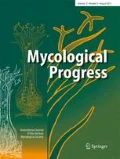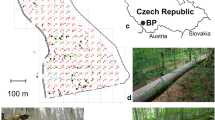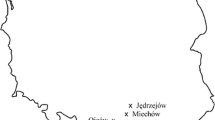Abstract
Species richness and composition of macrofungi on huge fallen trunks of spruce (Picea abies) were monitored at a model old-growth forest locality, Boubínský prales virgin forest (Czech Republic). Using detailed survey of all macrofungal groups based on fruit bodies, 168 species were recorded on 33 trunks with a diameter of 100–150 cm, which is a very high species richness. Individual trunks were inhabited by 6–32 species. The number of species per trunk was positively correlated with increasing tree cover, medium decay stages, and decreasing altitude. The species-richest groups were resupinate fungi with annual basidiomata and fleshy saprotrophic fungi. Species composition on particular trunks was significantly influenced by percentage of bark cover, altitude, and decay stage and to a lesser degree also by percentage of trunk contact with the soil and cover of mosses, trees, and shrubs. Resupinate fungi and fleshy saprotrophs were distributed along the entire decay gradient. Most polypores prevailed in early decay stages. Mycorrhizal agarics were associated with the latest stages. The presence of dominant species Fomitopsis pinicola had a low effect on the composition of other fungal species on the same trunk, whereas Phellinus nigrolimitatus had a significant effect. The monitoring revealed 71% of species known at the locality from spruce, and 45 species new to the locality, especially those with inconspicuous fruit bodies. The previously published field survey was more efficient for capturing rare species with larger fruit bodies. Both methods should be combined during mycobiota inventories.







Similar content being viewed by others
References
Abrego N, Salcedo I (2013) Variety of woody debris as the factor influencing wood-inhabiting fungal richness and assemblages: Is it a question of quantity or quality? Forest Ecol Manag 291:377–385
Abrego N, Halme P, Purhonen J, Ovaskainen O (2016) Fruit body based inventories in wood-inhabiting fungi: Should we replicate in space or time? Fungal Ecol 20:225–232
Abrego N, Christensen M, Bässler C, Ainsworth AM, Heilmann-Clausen J (2017) Understanding the distribution of wood-inhabiting fungi in European beech reserves from species-specific habitat models. Fungal Ecol 27:168–174
Baldrian P, Zrůstová P, Merhautová V, Vrška T (2016) Fungi associated with decomposing deadwood in a natural beech-dominated forest. Fungal Ecol 23:109–122
Bässler C, Müller J, Svoboda M, Lepšová A, Hahn C, Holzer H, Pouska V (2012) Diversity of wood-decaying fungi under different disturbance regimes - a case study from spruce mountain forests. Biodivers Conserv 21:33–49
Bernicchia A, Gorjón SP (2010) Corticiaceae s.l. Edizioni Candusso, Alassio
Boddy L, Watkinson SC (1995) Wood decomposition, higher fungi, and their role in nutrient redistribution. Can J Bot 73:1377–1383
Brazee NJ, Lindner DL, D’Amato AW, Fraver S, Forrester JA, Mladenoff DJ (2014) Disturbance and diversity of wood-inhabiting fungi: effects of canopy gaps and downed woody debris. Biodivers Conserv 23:2155–2172
Brūmelis G, Oļehnoviča E, Šūba U, Treimane A, Inne S, Zviedre E, Elferts D, Dakša M, Tjarve D (2017) Bryophyte and polypore richness and indicators in relation to type, age and decay stage of coarse woody debris of Picea abies. Environ Exper Bot 15:95–103
Core Team R (2019) R: a language and environment for statistical computing. R Foundation for Statistical Computing, Vienna
Crowther TW, Maynard DS, Crowther TR, Peccia J, Smith JR, Bradford MA (2014) Untangling the fungal niche: the trait-based approach. Front Microbiol 5:579
Dvořák D, Vašutová M, Hofmeister J, Beran M, Hošek J, Běťák J, Burel J, Deckerová H (2017) Macrofungal diversity patterns in central European forests affirm the key importance of old-growth forests. Fungal Ecol 27:145–154
Edman M, Jonsson BG (2001) Spatial pattern of downed logs and wood-decaying fungi in an old-growth Picea abies forest. J Veg Sci 12:609–620
Faraway JJ (2016) Extending the linear model with R, 2nd edn. CRC Press, Boca Raton
Hansen L, Knudsen H (eds) (2000) Nordic macromycetes, vol 1. Ascomycetes. Nordsvamp, Copenhagen
Heilmann-Clausen J (2001) A gradient analysis of communities of macrofungi and slime moulds on decaying beech logs. Myc Res 105:575–596
Heilmann-Clausen J, Christensen M (2004) Does size matter? On the importance of various dead wood fractions for fungal diversity in Danish beech forests. Forest Ecol Manag 201:105–117
Heilmann-Clausen J, Aude E, Christensen M (2005) Cryptogam communities on decaying deciduous wood – does tree species diversity matter? Biodivers Conserv 14:2061–2078
Hofmeister J, Hošek J, Brabec M, Dvořák D, Beran M, Deckerová H, Burel J, Kříž M, Borovička J, Běťák J, Vašutová M, Malíček J, Palice Z, Syrovátková L, Steinová J, Černajová I, Holá E, Novozámská E, Čížek L, Iarema V, Baltaziuk K, Svoboda T (2015) Value of old forest attributes related to cryptogam species richness in temperate forests: A quantitative assessment. Ecol Indic 57:497–504
Holec J, Beran M (eds) (2006) Červený seznam hub (makromycetů) České republiky [Red list of fungi (macromycetes) of the Czech Republic]. Příroda 24:1–282
Holec J, Kříž M, Pouzar Z, Šandová M (2015) Boubínský prales virgin forest, a Central European refugium of boreal-montane and old-growth forest fungi. Czech Mycol 67:157–226
Holec J, Běťák J, Dvořák D, Kříž M, Kuchaříková M, Krzyściak-Kosińska R, Kučera T (2019) Macrofungi on fallen oak trunks in the Białowieża Virgin Forest – ecological role of trunk parameters and surrounding vegetation. Czech Mycol 71:65–89
Hoppe B, Purahong W, Wubet T, Kahl T, Bauhus J, Arnstadt T, Hofrichter M, Buscot F, Krüger D (2016) Linking molecular deadwood-inhabiting fungal diversity and community dynamics to ecosystem functions and processes in Central European forests. Fung Divers 77:367–379
Jönsson MT, Edman M, Jonsson BG (2008) Colonization and extinction patterns of wood-decaying fungi in a boreal old-growth Picea abies forest. J Ecol 96:1065–1075
Juutilainen K, Halme P, Kotiranta H, Mönkkönen M (2011) Size matters in studies of dead wood and wood-inhabiting fungi. Fungal Ecol 4:342–349
Juutilainen K, Mönkkönen M, Kotiranta H, Halme P (2014) The effects of forest management on wood-inhabiting fungi occupying dead wood of different diameter fractions. Forest Ecol Manag 313:283–291
Juutilainen K, Mönkkönen M, Kotiranta H, Halme P (2017) Resource use of wood-inhabiting fungi in different boreal forest types. Fungal Ecol 27:96–106
Kazartsev I, Shorohova E, Kapitsa E, Kushnevskaya H (2018) Decaying Picea abies log bark hosts diverse fungal communities. Fungal Ecol 33:1–12
Knudsen H, Vesterholt J (eds) (2012) Funga Nordica, Agaricoid, boletoid, clavarioid, cyphelloidand gastroid genera. Nordsvamp, Copenhagen
Kotiranta H, Niemelä T (1996) Threatened polypores in Finland, second revised edition. Helsinki, Finnish Environment Institute and Edita
Kubart A, Vasaitis R, Stenlid J, Dahlberg A (2016) Fungal communities in Norway spruce stumps along a latitudinal gradient in Sweden. Forest Ecol Manag 371:50–58
Kubartová A, Ottosson E, Dahlberg A, Stenlid J (2012) Patterns of fungal communities among and within decaying logs, revealed by 454 sequencing. Mol Ecol 21:4514–4532
Küffer N, Gillet F, Senn-Irlet B, Aragno M, Job D (2008) Ecological determinants of fungal diversity on dead wood in European forests. Fungal Divers 30:83–95
Legendre P, Legendre L (2012) Numerical ecology. Elsevier, Amsterdam
Lepšová A, Pouska V (2014) Rare and threatened wood-decaying fungi in the nature protected area around Trojmezná, Plechý, and Smrčina, Bohemia Forest, Czech Republic. Eur J Environ Sci 4:37–46
Lindblad I (1998) Wood-inhabiting fungi on fallen logs of Norway spruce: relations to forest management and substrate quality. Nordic J Bot 18:243–255
Lindenmayer DB, Laurance WF, Franklin JF (2012) Global decline in large old trees. Science 338:1305–1306
Mäkipää R, Rajala T, Schigel D, Rinne KT, Pennanen T, Abrego N, Ovaskainen O (2017) Interactions between soil- and dead wood-inhabiting fungal communities during the decay of Norway spruce logs. The ISME Journal 11:1964–1974
Muscolo A, Bagnato S, Sidari M, Mercurio R (2014) A review of the roles of forest canopy gaps. J Forest Res 25:725–736
Niemelä T, Renvall P, Penttilä R (1995) Interactions of fungi at late stages of wood decomposition. Ann Bot Fenn 32:141–152
Nordén B, Ryberg M, Götmark F, Olausson B (2004) Relative importance of coarse and fine woody debris for the diversity of wood-inhabitating fungi in temperate broadleaf forests. Biol Conserv 117:1–10
Ottosson E, Nordén J, Dahlberg A, Edman M, Jönsson M, Larsson K-H, Olsson J, Penttilä R, Stenlid J, Ovaskainen O (2014) Species associations during the succession of wood-inhabiting fungal communities. Fungal Ecol 11:17–28
Ottosson E, Kubartová A, Edman M, Jönsson M, Lindhe A, Stenlid A, Dahlberg A (2015) Diverse ecological roles within fungal communities in decomposing logs of Picea abies. FEMS Microbiol Ecol 91:fiv012
Parmasto E, Parmasto I (1997) Lignicolous Aphyllophorales of old and primeval forests in Estonia. 1. The forests of northern Central Estonia with a preliminary list of indicator species. Fol Crypt Eston 31:38–45
Penttilä R, Siitonen J, Kuusinen M (2004) Polypore diversity in managed and old-growth boreal Picea abies forests in southern Finland. Biol Conserv 117:271–283
Pouska V, Lepš J, Svoboda M, Lepšová A (2011) How do log characteristics influence the occurrence of wood fungi in a mountain spruce forest? Fungal Ecol 4:201–209
Pouska V, Svoboda M, Lepš J (2013) Co-occurrence patterns of wood-decaying fungi on Picea abies logs: does Fomitopsis pinicola influence the other species? Polish J Ecol 61:119–133
Pouska V, Macek P, Zíbarová L, Ostrow H (2017) How does the richness of wood-decaying fungi relate to wood microclimate? Fungal Ecol 27:178–181
Purhonen J, Huhtinen S, Kotiranta H, Kotiaho JS, Halme P (2017) Detailed information on fruiting phenology provides new insights on wood-inhabiting fungal detection. Fungal Ecol 27:175–177
Rajala T, Peltoniemi M, Hantula J, Mäkipää R, Pennanen T (2011) RNA reveals a succession of active fungi during the decay of Norway spruce logs. Fungal Ecol 4:437–448
Rajala T, Peltoniemi M, Pennanen T, Mäkipää R (2012) Fungal community dynamics in relation to substrate quality of decaying Norway spruce (Picea abies [L.] Karst.) logs in boreal forests. FEMS Microbiol Ecol 81:494–505
Rajala T, Tuomivirta T, Pennanen T, Mäkipää R (2015) Habitat models of wood-inhabiting fungi along a decay gradient of Norway spruce logs. Fungal Ecol 18:48–55
Rayner ADM, Boddy L (1988) Fungal decomposition of wood: Its biology and ecology. John Wiley & Sons, Bath
Renvall P (1995) Community structure and dynamics of wood-rotting basidiomycetes on decomposing conifer trunks in northern Finland. Karstenia 35:1–51
Runnel K, Lõhmus A (2017) Deadwood-rich managed forests provide insights into the old-forest association of wood-inhabiting fungi. Fungal Ecol 27:155–167
Runnel K, Tamm H, Lõhmus A (2015) Surveying wood-inhabiting fungi: most molecularly detected polypore species form fruit-bodies within short distances. Fungal Ecol 18:93–99
Ruokolainen A, Shorohova E, Penttilä R, Kotkova V, Kushnevskaya H (2018) A continuum of dead wood with various habitat elements maintains the diversity of wood-inhabiting fungi in an old-growth boreal forest. Eur J Forest Res 137:707–718
Ryvarden L, Gilbertson RL (1993) European polypores, part 1, Abortiporus - Lindtneria. Fungiflora, Oslo
Ryvarden L, Gilbertson RL (1994) European polypores, part 2, Meripilus - Tyromyces. Fungiflora, Oslo
Ryvarden L, Melo I (2014) Poroid fungi of Europe. Fungiflora, Oslo
Šmilauer P, Lepš J (2014) Multivariate analysis of ecological data using Canoco 5. Cambridge University Press, Cambridge
Stokland JN, Siitonen J, Jonsson BG (2012) Biodiversity in dead wood. Cambridge University Press, Cambridge
Strid Y, Schroeder M, Lindahl B, Ihrmark K, Stenlid J (2014) Bark beetles have a decisive impact on fungal communities in Norway spruce stem sections. Fungal Ecol 7:47–58
Svantesson S (2012) Ecological requirements of corticioid fungi – a study on species richness and community composition in south-eastern Norway. Institutionen för biologi och miljövetenskap, Göteborgs universitet
ter Braak CJF, Šmilauer P (2012) Canoco reference manual and user's guide: software for ordination, version 5.0. Microcomputer Power, Ithaca
Valentín L, Rajala T, Peltoniemi M, Heinonsalo J, Pennanen T, Mäkipää R (2014) Loss of diversity in wood-inhabiting fungal communities affects decomposition activity in Norway spruce wood. Front Microbiol 5(230):1–11
Vrška T, Šamonil P, Unar P, Hort L, Adam D, Král K, Janík D (2012) Development dynamics of virgin forest reserves in the Czech Republic. Vol. 3. Šumava Mts. and Český les Mts. – Diana, Stožec, Boubín virgin forest, Milešice virgin forest. Academia, Praha
Wood SN (2017) Generalized additive models, 2nd edn. CRC Press, Boca Raton
Acknowledgements
We thank Dušan Adam and Tomáš Vrška (Silva Tarouca Research Institute, Brno) for data support (stem position maps and related databases), Zdeněk Pouzar (Prague), Petr Vampola (Smrčná near Jihlava) and Markéta Šandová (National Museum, Prague) for identification/revision of some fungal species and Petr Šmilauer (University of South Bohemia, České Budějovice) for statistical support. We thank anonymous reviewers for their comments.
Funding
Jan Běťák and Libor Hort were financially supported by project No. EHP-CZ02-OV-1-069-01-2014 and Institutional subsidy VUKOZ-IP-0002 7073. The summarisation of the results by Jan Holec was sponsored by the Ministry of Culture of the Czech Republic (DKRVO 2018/08, National Museum, 00023272).
Author information
Authors and Affiliations
Corresponding author
Additional information
Section Editor: Dominik Begerow
Publisher’s note
Springer Nature remains neutral with regard to jurisdictional claims in published maps and institutional affiliations.
Electronic supplementary material
ESM 1
(PDF 1.29 MB)
Rights and permissions
About this article
Cite this article
Holec, J., Kučera, T., Běťák, J. et al. Macrofungi on large decaying spruce trunks in a Central European old-growth forest: what factors affect their species richness and composition?. Mycol Progress 19, 53–66 (2020). https://doi.org/10.1007/s11557-019-01541-y
Received:
Revised:
Accepted:
Published:
Issue Date:
DOI: https://doi.org/10.1007/s11557-019-01541-y




